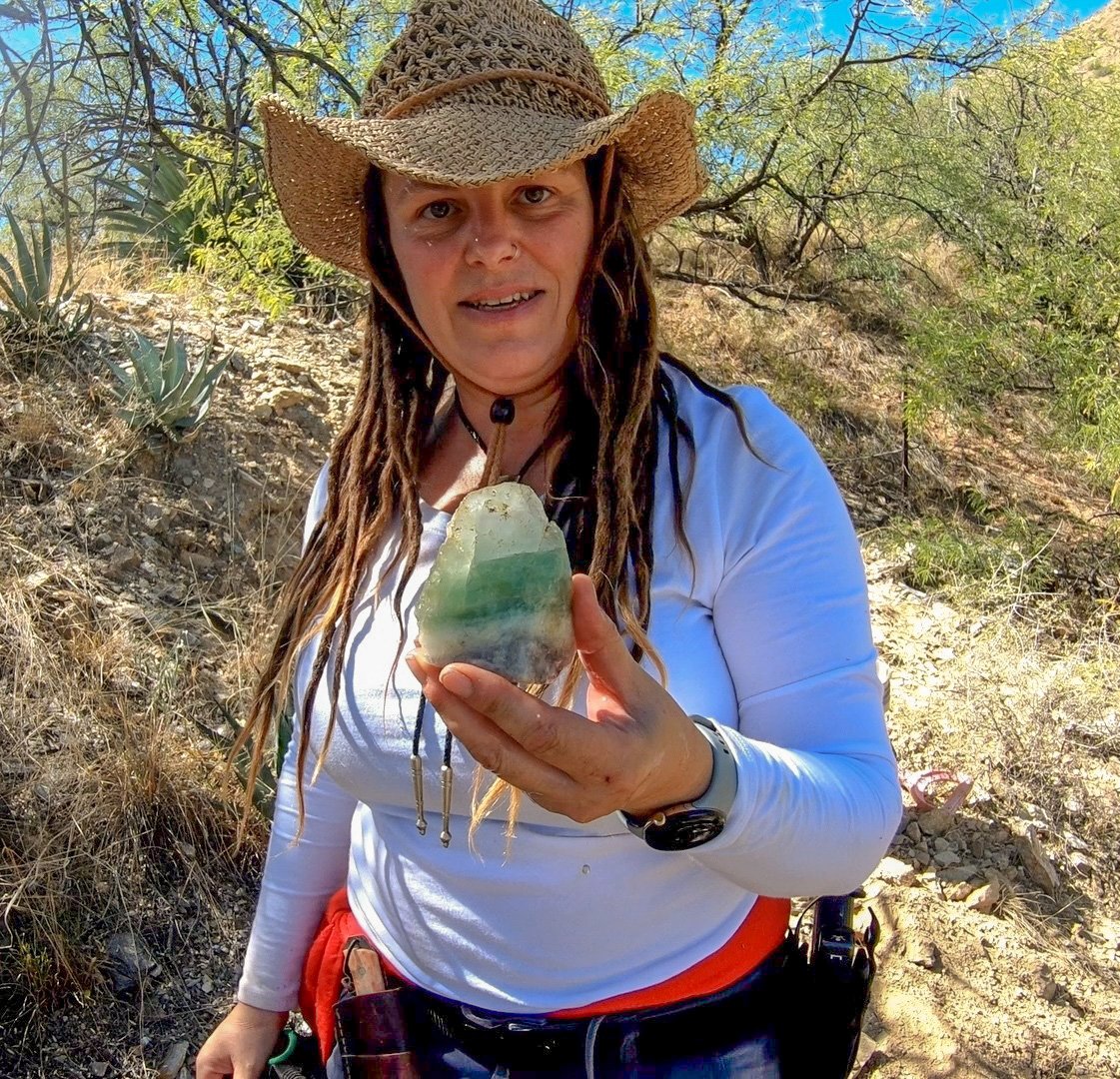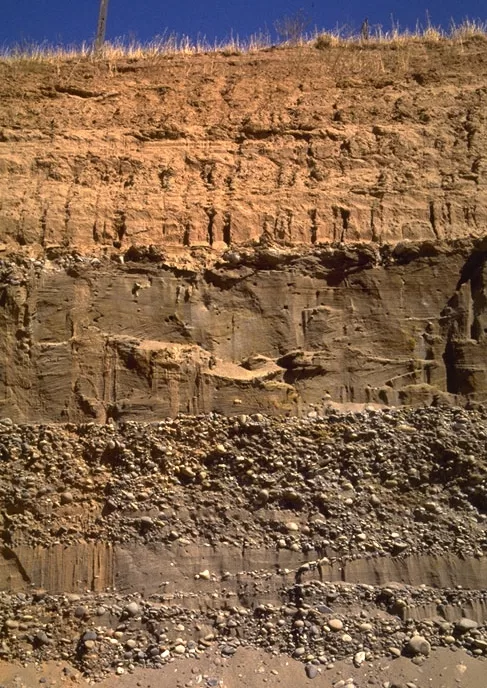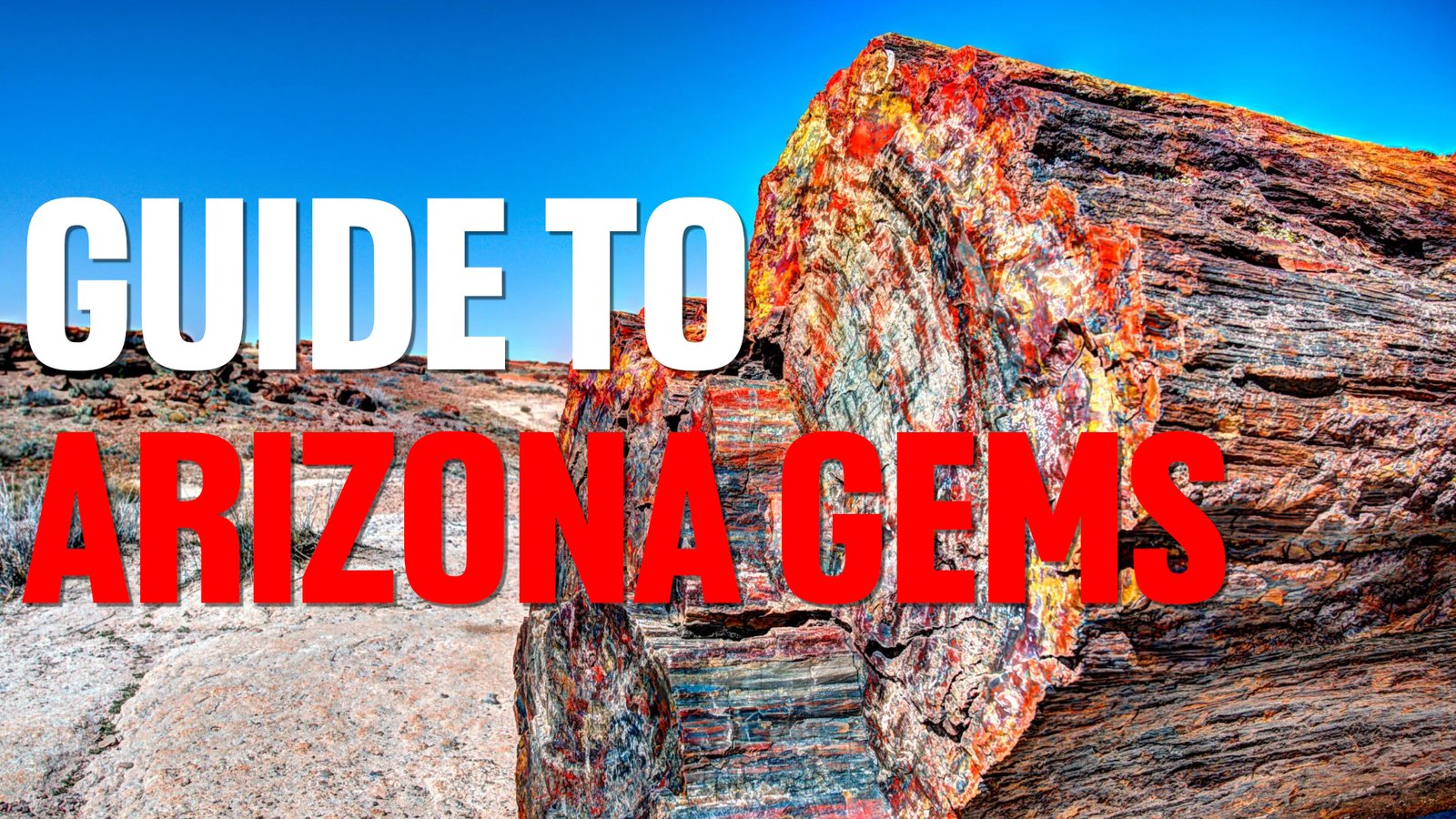As an avid rockhound and Arizona resident, I was a little stunned yet very pleased to find out that Arizona is the most prolific producer of Peridot in the entire WORLD (1).
Yes, you heard that right. I was shocked too. Usually gemstones like this come from Africa or Sri Lanka. But right here in Arizona is where Peridot is mined by the thousands.
Fortunately, there are a few sites that are open to the public (for a small fee) so you can find Arizona Peridot, which is a rockhounders dream come true.
However, it is important to know how Peridot is formed, what it looks like as a raw stone, how to rockhound for Arizona Peridot, and where the deposits are in order to have a successful gemstone hunt.
In this article, I am going to teach you everything you need to know about Arizona Peridot so you can find this beautiful gemstone for yourself!
Once you are finished reading this, head on over to my Arizona Gemstone and Rockhound Guide to learn about all the amazing gemstones of Arizona.
NEW: Arizona Rockhounding Tours with Regina!
Come dig with me at the Lone Star Mine

The Lone Star Mine is a fluorite mine that is loaded with thousands of pounds of crystals still in the tailings. It is located in Cochise County, one hour southeast of Tucson. Come on out and I will take you on an adventure you will never forget!
How Arizona Peridot is Formed
Peridot is a popular gem variety known as the mineral olivine, prized for its vivid green color. It’s been used in jewelry for thousands of years, with the earliest known peridot artifacts dating back to ancient Egypt. Peridot's signature green results from the presence of iron in its chemical composition. Stones with a deeper green hue tend to have a higher iron content.

The most valuable peridot gems have a bright, lime green color without any brown or yellow tinges. Finer quality peridot also exhibits high clarity without any inclusions or flaws visible to the eye.

Peridot rates 6.5-7 on the Mohs hardness scale, so while it is susceptible to scratching, it can still be worn in jewelry with proper care.

Arizona Peridot forms deep in the Earth’s mantle. It crystallizes in magma inside igneous rocks such as basalt. Tectonic shifts occasionally bring peridot closer to the surface where erosion of the basalt frees the gems.

This natural process is what made the rich peridot deposits in Arizona's San Carlos Reservation accessible to miners.
Where Arizona Peridot Deposits Occur
One of the best places to locate Arizona Peridot is in alluvial deposits where Peridot bearing rock is present.
These deposits occur when the basalt or other host bearing rock containing the Peridot erodes and the gemstones are then carried downstream by flowing water. The movement tumbles and smooths the raw Peridot into rounded pebbles.

Over time, these Peridot pebbles accumulate in active or ancient streambeds and floodplains along with other eroded minerals and rocks.
The best Arizona Peridot alluvial deposits occur downstream from host rocks like basalt and olivine-rich volcanic formations. Ideal conditions involve a steady supply of peridot crystals weathering out from the host rock, then getting transported downhill by streams over many years.

Pro Rockhounding Tip: How to Identify an Alluvial Deposit
Here are some quick tips to know that you are on an alluvial deposit:
Composition - Alluvial deposits are made up of small particles of eroded rocks, minerals, and organic matter that are carried downstream as flowing water loses energy. This creates an assorted mix of gravel, sand, silt, clay, etc.
Formation - They are formed gradually over time as flooding rivers overflow their banks and deposit sediments on floodplains or beds of rivers and streams. Repeated flooding events build up the deposits.
Location - Alluvial deposits are found along river beds, in former river channels, in lower parts of alluvial fans, and in inland deltas. Anywhere flowing water slows down enough to drop sediment.
Structure - The particles are loosely consolidated and sorted by size/density. Larger, dense pebbles and gravel deposit first, while fine silts and clays are carried farther downstream. This creates layers of different sediment sizes.
Mineral Content - Alluvial deposits often contain valuable minerals like gold, gemstones, or rare earth elements that eroded out of rocks upstream. These heavier minerals accumulate in alluvial deposits.
Fossils - Bone, teeth, and plant material fossils are also found in some alluvial deposits, since organic matter can be washed in along with mineral sediment.
Identifying Raw Arizona Peridot
It is important to know what raw Arizona Peridot looks like so you can spot it among the other gravels in the alluvial deposit.

Arizona Peridot is found as rounded and pitted nuggets or pebbles that have been tumbled smooth by river water. These nuggets are typically small, just a few carats in size, and have an olive-green color that lacks the vibrant lime hues of polished peridot.

The raw stones are translucent rather than transparent and have a waxy luster. Examining the stones with magnification shows natural etchings, mineral fingerprints, and crystal growth structures on the uneven surfaces.

Arizona Peridot can also be found intact on its host rock as beautiful druzy clusters.
Tools Needed for Mining Arizona Peridot
You will need to be prepared to extract the fine green gemstones from the rough gravels and sands. These are the tools you will want to consider using:
Collapsible Shovel - great for hiking, backpacking, and rockhounding in remote locations.

Rock Hammer - if there is ONE THING you invest in, get a good sturdy rock hammer. I use mine all the time! This is the exact rock hammer I use made by Estwing. It is a super solid hammer that I've had for years. You will only have to buy it once.

Classifiers - you will need gravel classifiers to get the right sized material for picking out Arizona Peridot gems. I use classifiers for many rockhounding instances, such as digging for crystals, classifying for gold panning, and getting rid of sand and dirt. I recommend getting a set as you will find purpose for each size.

Gold Pan - Once you have your properly classified materials, you will need a pan to pour the material into so you can sift through the gravels for Arizona Peridot stones.

Bucket - you will want to use a bucket when classifying your material so you can rock the pan back and forth, and it also catches all the classified gravels. Trust me, you will save your arm strength using this method! A five gallon bucket will work with the classifier pans.

Spray Bottle - getting the gravels and stones wet will help the Peridot stand out, especially if they are covered in dirt and debris.

Arizona Peridot Mining Techniques
Now that you have all of your tools, its time to extract the precious green gemstones!
Step One. Collect gemstone bearing gravels.
Use your rock hammer and shovel to break loose and collect the gravels that you will run through your classifier.
Step Two. Run the gravels and dirt through classifiers.
I recommend using a larger classifier and catching the smaller gravels in a bucket. Then you use a smaller classifier to keep the gravels intact and sift out sand and dirt. Once you have your properly classified gravels, its time to hunt!
Step Three. Pour classified materials into gold pan.
Once you have the materials in the pan, start shaking and sloshing the gravels around. What happens, just like gold, is that the Peridot will sink to the bottom as it is heavier than the regular gravels. Then, you flip over the pan onto a flat surface. The Arizona Peridot will now be on the top!
Step Four. Mist the materials.
Now you mist your materials so the green gemstones will stand out from the gravels. Collect the Peridot gems with tweezers or your bear hands. It helps if you are looking at the materials in the sun as it will cause the green Peridot to shine and stand out.

Arizona Peridot Rockhounding Locations
Now, the moment you have been waiting for! Here are the known locations where Arizona Peridot can be found.
San Carlos Apache Reservation
The San Carlos Apache Reservation is located roughly 1.5 hours from Mesa, AZ and is located along Highway 70 past Globe, AZ going east. In order to do any recreational activities, such as hiking, wildflower viewing, and prospecting, you will have to start with the $10 recreation permit that you can purchase at the San Carlos Apache Tribe Recreation & Wildlife office. Their official website is currently down, so if you want more information about the permit, you will have to call them to gather more information.
Within the reservation, the Arizona Peridot occurs on Peridot Mesa. This area is full of beautiful wildflowers in the spring and is a lovely place to visit and enjoy nature.

However, just because you have the recreation permit, does not mean you are allowed to start prospecting. The Peridot Mesa mine is claimed and you will need to contact the mine owner to be allowed to do any prospecting on the property. Luckily, this mine owner has his information posted online and you can contact him through phone or email to purchase Arizona Peridot or go on a lovely day of rockhounding. His business website is www.peridotdreams.com.
This location is not the only place you can find Arizona Peridot, however this is the highest quality and abundance in Arizona, so it is worth the hoops to jump through if you are an avid Arizona rockhound.
Olivine Basalt Pits, Yavapai County
This little known location is about 50 miles east of Flagstaff and is about 40 miles north of Prescott. Very little information is known about this open pit mine, but it is a basalt outcropping with olivine inclusions. Here is the link to the location which is made available on mindat.org.

This location is in the Kaibab National Forest, so it is public lands and it appears there is no active claim on it. However, you will have to do your own research to ensure that the location is available to prospecting activity. Here is the link to the Kaibab National Forest land use and permitting web page. You can always call and talk to a forestry agent to see what their terms are when it comes to prospecting.
You would have to go explore the area to see the quality of the olivine. I have not personally visited this location yet, but when I do, I will update you on my findings.
San Francisco Volcanic Fields
These gorgeous and striking volcanic fields are located just northeast of Flagstaff and is worth going just to see the spectacular volcanic formations!

The access to this location is great because it is located within the Coconino and Kaibab National Forests and has lots of forestry roads. You can access the volcanoes off of Hwy 89 at these coordinates: 35.371487°, -111.574983°.
Basalt occurences have been reported here all the way to Williams, AZ. Search for Basalt outcroppings with Olivine inclusions. Now this place will be a real treasure hunt as you meander through ancient volcanic craters! Many types of gems and minerals occur with volcanoes, but be sure to wear good gloves and hiking boots as volcanic rock is very sharp and can cut like glass.
Buell Park Kimberlite, Defiance Plateau
The Buell Park Mine is located in Apache County in the Navajo Nation Tribal Lands reservation.
You will need to obtain permitting from the Navajo Nation to recreate on their lands,
Arizona Peridot For Sale
Now that you have been informed of how challenging and remote the hunt for Arizona Peridot is, you may just want to buy it. So here is a purchasing guide to where you can buy authentic Arizona Peridot!
Etsy for Sourcing Arizona Peridot
I personally love using Etsy for sourcing very specific stones. I like supporting the smaller sellers because they work very hard to find these rare gemstones and are transparent about where the stones come from. You can check out these Etsy listings which shows Arizona Peridot that is raw and rough, all the way to polished, tumbled, and even fancy cut.
Raw Arizona Peridot For Sale on Etsy
OldWorldGems has several Arizona Peridot specimens for sale. He personally sourced these from a San Carlos tribal member (likely the claim owner) and is authentic Peridot from Arizona.

Tumbled Arizona Peridot Chips For Sale on Etsy
GeocomMinerals offers vials of beautiful vivid green tumbled Arizona Peridot from San Carlos for a very affordable price. Its a great way to own this rare gemstone without breaking the bank.

Cut Arizona Peridot Gemstones for Sale on Etsy
I found this stunner gemstone that is precision cut and weighs a whopping 5.06 carats! If you are wanting to splurge on a large brilliant Arizona Peridot, then this is the one for you.

Conclusion
If you are wanting to rockhound for Arizona Peridot, you are going to have to work for it. Mother nature isn't going to make this easy for you. You will need to make phone calls, get permissions and permits, and travel a good deal to get the best peridot. You can also be adventurous and trek into the very remote locations I gave to you, learn geology and what to look for, and be prepared to work hard to get these gifts from the Earth.
Me personally, I love going on the hunt! I am planning to make a visit to these remote locations and search for undiscovered Arizona Peridot deposits!
However, if you want the gemstone, you absolutely can have it, you just need to cough up some dough and make the purchase of your dreams.
Good luck in your mission to find Arizona Peridot and please leave a comment below with your thoughts and adventures!



